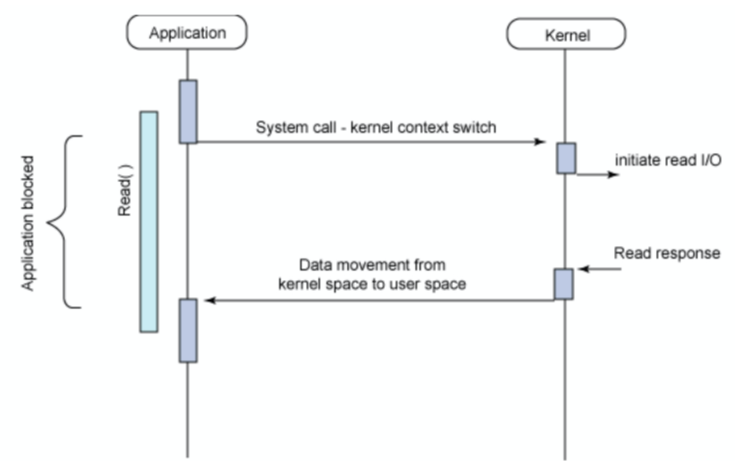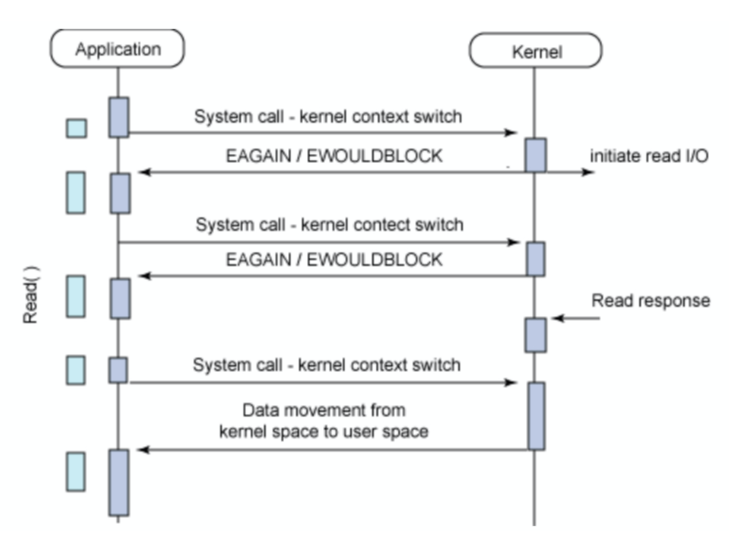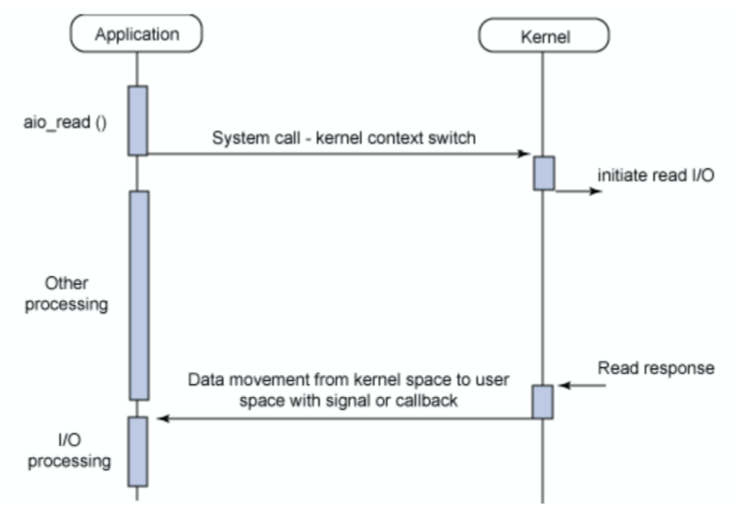##Sync VS Async
어원
- Synchronous의 Syn는 together이란 뜻이고, chrono는 time이다. 따라서 Synchronous는 함께 시간을 맞춘다라는 뜻으로 해석된다.
- Asynchronous는 앞에 A라는 접두사가 붙어 부정하는 형태가 되어 시간을 맞추지 않는 것이라 해석할 수 있다.
>> Sync와 Async는 대상이 누구인지, 그 대상들의 시간은 어떻게 다루어지는지 두 가지를 살펴봐야한다.
1. Synchronous (동기)
-
동기는 두 가지 이상의 대상(함수, 애플리케이션 등)이 서로 시간을 맞춰 행동하는 것이다.
-
예를들어 호출한 함수가 호출된 함수의 작업이 끝나서 결과값을 반화하기를 기다리거나, 지속적으로 호출된 함수에게 확인 요청을하는 경우가 있다.
어떤 대상 A와 B가 있을 때 동기적으로 처리하는 방법 두 가지
- A와 B가
시작 시간 또는 종료 시간이 일치
하면 동기이다.
- A, B 쓰레드가 동시에 작업을 시작하는 경우 (예를 들면 자바에서 CyclicBarrier)
- 메서드 리턴 시간(A)과 결과를 전달받는 시간(B)이 일치하는 경우

-
A가 끝나는 시간과 B가 시작하는 시간이 같으면 동기
이다.
- 예를 들어 자바에서
synchronized와 BlockingQueue가 위와 같은 경우이다.

2. Asynchronous (비동기)
-
비동기는 동기와 반대로 대상이 서로 시간을 맞추지 않는 것을 말한다.
-
예를 들어 호출하는 함수가 호출되는 함수에게 작업을 맡겨놓고 신경을 쓰지 않는 것을 말한다.
##Blocking VS Non-Blocking
-
블록킹/논블록킹을 동기/비동기와 같이 생각하는 경우가 많은데, 이는 서로 관점이 다르다.
-
블록킹/논블록킹은 직접 제어할 수 없는 대상을 처리하는 방법에 따라 나눈다.
-
직접 제어할 수 없는 대상은 대표적으로 IO, 멀티쓰레드 동기화가 있다.
1. Blocking
- Blocking은 직접 제어할 수 없는 대상의 작업이 끝날 때까지 제어권을 넘겨주지 않는 것이다.
- 예를 들어 호출하는 함수가 IO를 요청했을 때 IO처리가 완료될 때까지 아무 일도 하지 못한 채 기다리는 것을 말한다.
2. Non-Blocking
- Non-Blocking은 Blocking과 반대되는 개념이다.
- 직접 제어할 수 없는 대상의 작업 처리 여부와 상관이 없다.
- 예를 들어 호출하는 함수가 IO를 요청한 후 IO처리 완료 여부와 상관없이 바로 자신의 작업을 할 수 있다.
##Sync/Async, Blocking/Non-Blocking 예제
동기/비동기와 블록킹/논블록킹은 전혀 다른 개념으로 서로 독립적으로 바라봐야한다.
ExecutorService es = Executors.newCachedThreadPool();
String res = es.submit(() -> "Hello Async").get();위 코드에서 동기/비동기, 블록킹/논블록킹을 분석해보자.
es.submit(() -> "Hello Async"): 비동기submit()메서드 리턴 시간과 Callable의 실행 결과를 받는 시간이 일치하지 않는다.- 블록킹/논블록킹을 고려할 대상이 아니다.
get(): 동기, 블록킹get()메서드 리턴 시간과 결과를 가져오는 시간이 일치한다. (동기)- 다른 쓰레드의 작업이 완료될 때까지 대기한다. (블록킹)
1. 애플리케이션 관점에서 Sync/Async
예를들어 물건을 주문하는 기능에서 물건을 주문하는데 0.5초가 소요되고, 주문 완료 후 메일을 발송하는데 2초가 소요된다고 하자. 동기와 비동기는 이를 처리하는 시간이 서로 다르다.
- Sync 응답 속도 = 2.5초
- Async 응답 속도(메일 발송을 Async로 처리) = 0.5초 + 알파
2. I/O 관점에서 Sync/Async, Blocking/Non-Blocking
1) Synchronous Blocking I/O

device = IO.open()
//# 이 thread는 데이터를 읽을 때까지 아무 일도 할 수 없음
data = device.read()
print(data)- Synchronous:
read()메서드(애플리케이션)가 리턴하는 시간과 커널에서 결과를 가져오는 시간이 일치한다. - Blocking: 커널의 작업이 완료될 때까지 대기한다.
2) Synchronous Non-Blocking I/O

device = IO.open()
ready = False
while not ready:
print("There is no data to read!")
// 다른 작업을 처리할 수 있음
// while 문 내부의 다른 작업을 다 처리하면 데이터가 도착했는지 확인한다.
ready = IO.poll(device, IO.INPUT, 5)
data = device.read()
print(data)- Synchronous:
read()메서드(애플리케이션)가 리턴하는 시간과 커널에서 결과를 가져오는 시간이 일치한다. - Non-Blocking: 애플리케이션으로부터 요청을 받은 커널은 작업 완료 여부와 상관없이 바로 반환하여 제어권을 애플리케이션에게 넘겨준다. 커널의 작업이 완료되면 작업 결과를 애플리케이션에게 반환한다.
- 대표적인 예로는 멀티플랙싱을 수행하는
select(),epoll()함수가 있다.
3) Asynchronous Non-Blocking I/O (AIO)

ios = IO.IOService()
device = IO.open(ios)
def inputHandler(data, err):
"Input data handler"
if not err:
print(data)
device.readSome(inputHandler)
// 이 thread는 데이터가 도착했는지 신경쓰지 않고 다른 작업을 처리할 수 있다.
ios.loop()- Asynchronous:
readSome()메서드(애플리케이션)가 리턴하는 시간과 커널에서 결과를 가져오는 시간이 일치하지 않는다. - Non-Blocking: 애플리케이션으로부터 요청을 받은 커널은 작업 완료 여부와 상관없이 바로 반환하여 제어권을 애플리케이션에게 넘겨준다. 작업이 끝나면 애플리케이션에게 시그널 또는 콜백을 보낸다.
- 대표적인 예로는 윈도우에서 멀티플랙싱을 수행하는 IOCP가 있다.(
epoll()보다 성능이 좋다.)
4) Asynchronous Blocking
-
Asynchronous Blocking 조합은 비효율적이라 직접적으로 사용하는 모델은 없다.
-
하지만 Asynchronous Non-Blocking 모델 중에서 Blocking 으로 동작하는 작업이 있는 경우 의도와 다르게 Asynchronous Blocking으로 동작할 때가 있다고 한다.
-
대표적인 예로는
Node.js와 MySQL을 함께 사용하는 경우
이다.
- Node.js는 비동기로 작업하려 하지만 MySQL 드라이버가 Blocking 방식으로 동작하므로 어쩔 수 없이 Asynchronous Blocking 방식으로 동작하게 된다.
##정리
- Synchronous VS Asynchronous
- 두 가지 이상의 대상(메서드, 작업, 처리 등)과 이를 처리하는 시간으로 구분한다.
- Synchronous: 호출된 함수의 리턴하는 시간과 결과를 반환하는 시간이 일치하는 경우
- Asynchronous: 호출된 함수의 리턴하는 시간과 결과를 반환하는 시간이 일치하지 않는 경우
- Blocking VS Non-Blocking
- 호출되는 대상이 직접 제어할 수 없는 경우 이를 구분할 수 있다.
- Blocking: 직접 제어할 수 없는 대상의 작업이 끝날 때까지 기다려야 하는 경우
- Non-Blocking: 직접 제어할 수 없는 대상의 작업이 완료되기 전에 제어권을 넘겨주는 경우
##자바의 비동기 프로그래밍
Java에서 데이터를 비동기 적으로 처리할 때 어떻게 수행하는지
- Thread, Runnable, Callable , Future (및 확장 된 ScheduledFuture ),
CompletableFuture 및 물론 ExecutorService 및 ForkJoinPool에서 시작한다.
##Thread
Java 동시성의 매우 기본적이지만 강력한 구성 요소는 Thread이다.
Java 스레드는 실제로 운영 체제의 스레드와 관련이 있다.
Thread를 생성하는 가장 기본적인 방법 : 확장하고 run 메소드 재정의
public class TestThread extends Thread{
@Override
public void run() {
// Logic
super.run();
}
}
TestThread t = new TestThread();
// starts thread
t.start();// starting the thread, causes the run method be called스레드를 시작하면 run () 메서드가 호출된다.
대부분의 경우 스레드의 다른 메서드를 재정의하는 건 권장않는 이유
-
Thread 클래스를 확장하면 Java가 다중 상속을 지원하지 않기 때문에 확장 클래스는 추가
확장 기능을 상실한다. -
각 스레드는 확장 할 때 자체 개체를 가지며, 확장 된 개체가
많이 Thread 생성 되면 메모리 상태
에 좋지 않다.
- 상속받으면 Thread에 있는 모든 클래스를 사용할 수있게 되므로 자원이 많이듬
>>Java는 Runnable 인터페이스로 이러한 문제를 해결
실제로 Thread에는 Runnable을 사용하는 오버로드 된 메서드가 있다
**인터페이스
: 클래스와 클래스 사이의 상호 작용의 규격을 나타낸 것
-
인터페이스에는 몸체가 없는 추상 메소드만 정의된다.
public interface RemoteControl { // 추상 메소드 정의 public void turnOn(); // 가전 제품을 켠다. public void turnOff(); // 가전 제품을 끈다. }
-
implements로 인터페이스를 구현한다.
public class Television implements RemoteControl { public void turnOn() { // 실제로 TV의 전원을 켜기 위한 코드가 들어 간다. } public void turnOff() { // 실제로 TV의 전원을 끄기 위한 코드가 들어 간다. } }
##Runnable
Runnable은 메소드가 하나 뿐인 인터페이스 : run().
Runnable은 기능적 인터페이스이며 해당 인스턴스는 람다 함수로 생성 가능
// With lambda
Runnable runnable = ()->System.out.println("I'm a runnable from lambda.");
// With implemention, we can hold the data and related stuff that we want to process.
// Otherwise we got to manage them in the launching thread
public class RunnableImplemented implements Runnable{
List<Object> mayBeAListOfData;
Object mayBeAService;
Object mayBeADao;
public RunnableImplemented(List<Object> mayBeAListOfData,
Object mayBeAService, Object mayBeADao) {
super();
this.mayBeAListOfData = mayBeAListOfData;
this.mayBeAService = mayBeAService;
this.mayBeADao = mayBeADao;
}
@Override
public void run() {
// code logic
}
}Runnable에는 run()메소드 가 있지만 스레드가 제어 (전달) 할 때까지는 스레드가 아니라 Java 클
래스 일뿐이다.
스레드가 시작되면 실행 가능한 개체의 run()메서드가 호출됨
public class TestThread {
private static Runnable runnable = ()->System.out.println("I'm a runnable from lambda.");
public static void main(String[] args) {
Thread t = new Thread(runnable);// takes runnable here
t.start();
}
}##Callable
- Callable은 일반 인터페이스이다.
- 제네릭 유형으로 반환 값의 유형이다.
- Callable은 너무 기능적인 인터페이스이며 call() 예외를 발생시키고, 제네릭 유형 값을 반환하는 인수가없는 유일한 메서드이다.
private static Callable<Integer> callable = ()-> {
String data = "I'm in callable.";
System.out.println();
return data.length();
};public static void main(String[] args) {
ExecutorService executor = Executors.newSingleThreadExecutor();
Future<Integer> callFuture = executor.submit(callable);
Integer integer = callFuture.get();
}여기에서 call 메서드는 데이터를 처리하고 실행 후 수집 할 수 있는 값을 반환
그러나 호출하는 데 큰 차이가 있을까?
- ExecutorService 를 사용하여 호출하고, Future를 사용하여 결과를 보유한다.
- 그 이유는?
- 스레드 (실행 가능 또는 호출 가능)를 만들고 실행하는 제어 된 동작이 없다.
- 각 스레드가 OS의 스레드와 관련되어 있으므로 한 번에 실행되는 스레드 수를 제어 할 수 있다.
- 우리가 실행하는 스레드 수는 사용 가능한 CPU 코어 수보다 적어야한다.
>> Java는 ExecutorService 인터페이스로 해결하자.
#Runnable과 Callable의 차이점
- Runnable: 어떤 객체도 리턴하지 않습니다. Exception을 발생시키지 않습니다.
- Callable: 특정 타입의 객체를 리턴합니다. Exception을 발생킬 수 있습니다.
[Future]
Future는 특정 작업에 대해 결과값을 받아올 수 있는 인터페이스이다.
예를 들어, 특정 비동기 작업을 실행시키는 메소드는 Future형 반환값을 내뱉고 이 Future형 반환값을 통해 나중에 작업이 완료됐을 때 .get()메소드를 통해 작업의 결과를 받아오거나 할 수 있다.
[Executor 인터페이스]
Executor 인터페이스란 특정 작업을 실행하는 execute 메소드를 갖는 Single Abstract Method 인터페이스이다.
##ExecutorService
- 쓰레드풀을 생성하여 병렬처리를 할 수 있음
Executors 메소드
- java.util.concurrent.Executor;
- 쓰레드 풀을 개수 및 종류를 정하는 메소드 :
- newFixedThreadPool(int) : 인자 개수만큼 고정된 쓰레드풀을 만듭니다.
- newCachedThreadPool() : 필요할 때, 필요한 만큼 쓰레드풀을 생성합니다. 이미 생성된 쓰레드를 재활용할 수 있기 때문에 성능상의 이점이 있을 수 있습니다.
- newScheduledThreadPool(int) : 일정 시간 뒤에 실행되는 작업이나, 주기적으로 수행되는 작업이 있다면 ScheduledThreadPool을 고려해볼 수 있습니다.
- newSingleThreadExecutor() : 쓰레드 1개인 ExecutorService를 리턴합니다. 싱글 쓰레드에서 동작해야 하는 작업을 처리할 때 사용합니다.
ExecutorService 메소드
- java.util.concurrent.ExecutorService;
- submit() :
- 작업처리
- submit(() → { })은 멀티쓰레드로 처리할 작업을 예약인자로 람다식 전달 가능
- shutdown()
- 더 이상 쓰레드풀에 작업을 추가하지 못하도록 함
- 처리 중인 Task가 모두 완료되면 쓰레드풀을 종료시킴
- awaitTermination()
- 이미 수행 중인 Task가 지정된 시간동안 끝나기를 기다림
- 지정된 시간 내에 끝나지 않으면, false를 리턴
- 이 때 shutdownNow()를 호출하면 실행 중인 Task를 모두 강제로 종료시킬 수 있음
public class ExecutorServiceTest {
public static void main(String args[]) throws InterruptedException {
ExecutorService executor = Executors.newFixedThreadPool(2);
executor.submit(() -> {
String threadName = Thread.currentThread().getName();
System.out.println("Job1 " + threadName);
});
executor.submit(() -> {
String threadName = Thread.currentThread().getName();
System.out.println("Job2 " + threadName);
});
// 더이상 ExecutorService에 Task를 추가할 수 없습니다.
// 작업이 모두 완료되면 쓰레드풀을 종료시킵니다.
executor.shutdown();
// shutdown() 호출 전에 등록된 Task 중에 아직 완료되지 않은 Task가 있을 수 있습니다.
// Timeout을 20초 설정하고 완료되기를 기다립니다.
// 20초 전에 완료되면 true를 리턴하며, 20초가 지나도 완료되지 않으면 false를 리턴합니다.
if (executor.awaitTermination(20, TimeUnit.SECONDS)) {
System.out.println(LocalTime.now() + " All jobs are terminated");
} else {
System.out.println(LocalTime.now() + " some jobs are not terminated");
// 모든 Task를 강제 종료합니다.
executor.shutdownNow();
}
System.out.println("end");
}
}##Future
- 예약된 작업에 대한 결과를 알 수 있다.
- executor.submit() : Future객체를 리턴
- future.get() : 작업이 종료될 때 까지 기다림
public class ExecutorServiceTest3 {
public static void main(String args[]) {
//Runtime.getRuntime().availableProcessors()는 현재 사용가능한 core 개수를 리턴
final int maxCore = Runtime.getRuntime().availableProcessors();
final ExecutorService executor = Executors.newFixedThreadPool(maxCore);
final List<Future<String>> futures = new ArrayList<>();
for (int i = 1; i < 5; i++) {
final int index = i;
futures.add(executor.submit(() -> { //executor.submit으로 List에 future 객체 add
System.out.println("finished job" + index);
return "job" + index + " " + Thread.currentThread().getName();
}));
}
for (Future<String> future : futures) {
String result = null;
try {
result = future.get(); //future.get()으로 작업 종료까지 기다림 > 출력
} catch (InterruptedException e) {
e.printStackTrace();
} catch (ExecutionException e) {
e.printStackTrace();
}
System.out.println(result);
}
executor.shutdownNow();
System.out.println("end");
}
}결과 : 작업은 순서대로 처리되지 않을 수 있지만, 로그는 순차적으로 출력
finished job1
finished job3
finished job2
job1 pool-1-thread-1
job2 pool-1-thread-2
job3 pool-1-thread-3
finished job4
job4 pool-1-thread-4
end##BlockingQueue
- java.util.concurrent.BlockingQueue;
- 그럼 무엇을 막을까?
- Queue가 꽉찼을때의 삽입 시도 / Queue가 비어있을때의 추출 시도를 막는다.
- 이 자동으로 '막는' 기능이 있어 BlockingQueue 의 구현체는 모두 Thread-safe 하다.
위의 Future의 단점:
- 작업이 늦게 처리된다면 다른 작업에 대한 로그도 늦게 출력이 됨
BlockingQueue로 단점 해결
- 작업이 끝날 때 BlockingQueue에 결과를 추가하고 메인쓰레드에서 Queue를 기다리면 됨
import java.util.List;
import java.util.concurrent.ExecutorService;
import java.util.concurrent.Executors;
import java.util.concurrent.ArrayBlockingQueue;
import java.util.concurrent.BlockingQueue;
public class ExecutorServiceTest4 {
public static void main(String args[]) {
ParallelExcutorService service = new ParallelExcutorService();
service.submit("job1");
service.submit("job2");
service.submit("job3");
service.submit("job4");
for (int i = 0 ; i < 4; i++) {
String result = service.take();
System.out.println(result);
}
System.out.println("end");
service.close();
}
private static class ParallelExcutorService {
private final int maxCore = Runtime.getRuntime().availableProcessors();
private final ExecutorService executor = Executors.newFixedThreadPool(maxCore);
private final BlockingQueue<String> queue = new ArrayBlockingQueue<>(10);
public ParallelExcutorService() {
}
public void submit(String job) {
executor.submit(() -> {
String threadName = Thread.currentThread().getName();
System.out.println("finished " + job);
String result = job + ", " + threadName;
try {
queue.put(result);
} catch (InterruptedException e) {
Thread.currentThread().interrupt();
}
});
}
public String take() {
try {
return queue.take();
} catch (InterruptedException e) {
Thread.currentThread().interrupt();
throw new IllegalStateException(e);
}
}
public void close() {
List<Runnable> unfinishedTasks = executor.shutdownNow();
if (!unfinishedTasks.isEmpty()) {
System.out.println("Not all tasks finished before calling close: " + unfinishedTasks.size());
}
}
}
}결과 : 처리한 순서대로 메인쓰레드에서 로그를 출력함
finished job1
finished job3
finished job4
finished job2
job1, pool-1-thread-1
job3, pool-1-thread-3
job4, pool-1-thread-4
job2, pool-1-thread-2
end참조 : https://dzone.com/articles/async-programming-in-java-part-i
https://velog.io/@codemcd/Sync-VS-Async-Blocking-VS-Non-Blocking-sak6d01fhx

